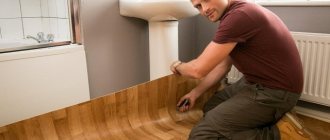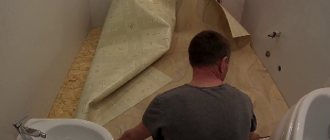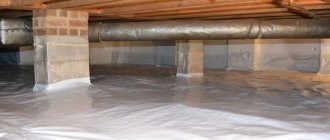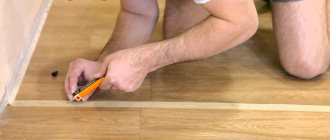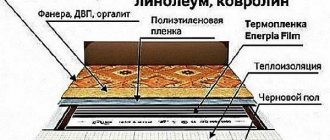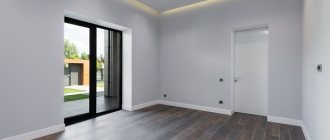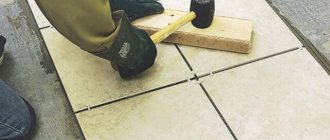To lay linoleum, you need to achieve a flat base surface. So the idea of laying linoleum on top of linoleum (without removing the old sheets) seems attractive. Professionals in the field of finishing work say that this is an acceptable technology, but it cannot be used in all cases. Let's figure out when it is possible to lay new linoleum on top of the old one, and when it is better to remove the old layer.
Requirements for the quality of the base for linoleum
Linoleum is the most popular type of flooring in our country. It successfully combines affordable cost, varied design, low maintenance requirements and ease of flooring. But, despite its unpretentiousness, this material makes certain demands on the base on which it will be laid:
- The surface must be smooth. According to the standards, a height difference of no more than 2 mm is allowed on any two-meter vector. This is due to the relative plasticity of linoleum: all the features of the relief will appear on the coating over time. And if there are dents or protrusions in the base, these will become points where the material will break through in the future.
- It is unacceptable for moisture to get under the linoleum. Water will cause the material to ripple and the floor will be hopelessly damaged. Therefore, the base must be thoroughly dried.
- The floor on which linoleum will be laid must have sufficient hardness. A base that is too soft will wash out along with the canvas (under the weight of furniture, pressure from heels, falling objects, etc.), which will ruin the look and lead to the appearance of holes.
Using laminate tiles instead of sheet linoleum does not soften the requirements, but, on the contrary, makes them more stringent. On an uneven base, the locks will constantly come apart, and the coating will quickly lose its aesthetic appearance.
A floor covered with linoleum theoretically satisfies all requirements. It must be carefully leveled and isolated from water even at the time of laying the old canvas. Therefore, the idea of installing a new layer on top of the old one that has not been removed looks very attractive.
Laminate
Externally, laminate is similar to parquet boards, but in terms of its internal structure it is a multilayer material made of MDF (or an analogue) and a protective coating on all sides. Unlike parquet, it does not need to be sanded and varnished. This is a completely ready-to-use coating. It is enough to install the laminate planks on the floor, and you can immediately walk around the room.
Advantages of laminate flooring
The classic laminate lamella has four layers from bottom to top:
- Moisture-resistant melamine-impregnated kraft paper or plastic.
- Support board made of MDF, chipboard or HDF with locks on the long side.
- Paper with a pattern to resemble veneer, leather, stone or tile.
- Top protective film made of acrylic or melamine.
Glue is used to hold them together. A hollow PVC board can also be used as a base. This option has better moisture resistance. It does not warp, has a smaller thickness and is more expensive than lamellas made from wood boards.
What does laminate consist of?
There are four main laminate strength classes:
- “31” – for bedrooms, libraries and other rooms with low load on the coating.
- “32” – for corridors, living rooms, kitchens and halls in apartments.
- “33” – for offices, bathrooms and home gyms.
- “34” – for public and other premises with heavy loads.
The higher the second digit in the class, the greater the wear resistance and service life of the laminate coating. But at the same time, the cost per square meter is also growing.
There are also very cheap options “21” and “22” with low abrasion resistance. However, they are now practically never found on sale.
In the laminate markings you can also find the letters “AC” with numbers from 3 to 6. Lamels with a three correspond to class “31”, and with a six – “34”.
How to determine the laminate class
Five reasons not to remove old coating
The attractiveness of each renovation solution can be assessed by reviewing the benefits it can provide.
This is what laying a new layer of linoleum on top of the old gives:
- Save time. Dismantling skirting boards, removing old fabric, cleaning (if necessary and repairing) screeds can take from several hours to several days.
- Saving money. Even if you do all the work yourself, during dismantling you will have to spend money on materials to seal cracks in the base.
- Less dirt and debris. Although they say that “breaking is not building,” it is at the dismantling stage that there will be a lot of scraps, debris and dust. All the garbage will have to be taken out, which will again affect the time spent on repairs.
- The old canvas will act as additional noise insulation. In addition, it will not allow heat to leave the room, and the cold base will not allow your feet to get cold.
- Extra softness. The double thickness of the coating will pleasantly spring under your feet and also muffle the sounds of steps.
The economic effect will be especially noticeable if the work of dismantling the old and creating a new floor covering is planned to be entrusted to a hired team. So, removing the old coating will cost about 80 rubles. per 1 m2, surface priming – another 50 rubles, removal of baseboards – about 30 rubles. per linear meter.
All these advantages show: laying new linoleum on an old layer is really beneficial. But experts in the field of finishing work warn against excessive optimism and advise you to first become familiar with the risks that such a decision brings.
We recommend: Why is an angle grinder called an angle grinder and not a Vietnamese angle grinder?
Negative consequences of laying new linoleum over old
There are several reasons why professional builders do not recommend laying linoleum on any surface other than a carefully prepared screed. For linoleum, the set of arguments looks like this:
- Any defects that are on the old coating will eventually appear on the new one.
- If the old canvas is not fastened well enough, the new layer of linoleum will quickly go in waves.
- If the sheet is torn by a heel or burned by a fallen match, it is much easier to repair it when there is a solid base underneath the coating. But if there is a second layer under one layer, it will be much more difficult to carry out repairs.
- Between the two layers of coating, ideal conditions are created for the development of mold fungi.
All these arguments are not absolute reasons for rejecting the idea. But before making a decision, you need to carefully weigh all the pros and cons.
Tip #3 – Choose a styling method and stick to the technique
The most common methods of installing linoleum are gluing with glue, mastic or double-sided tape; you just have to choose the one that suits you. As for the technique, everything here is also quite clear - roll the linoleum into a roll with the front side inward, and starting from the wall, glue the covering, gradually unrolling the roll and moving it in front of you. After completely rolling out the coating, go over the gluing lines with a construction roller. The force of its pressure will allow you to evenly smooth the material and squeeze out the air from under it.
Cases when it is better to remove old linoleum
There are several signs that indicate the need to dismantle the old coating to the level of the screed:
- Creases, waves, holes in the canvas are clear arguments in favor of dismantling. If the defects are few in number (one or two problem areas per room) and small in size, then we can hope that the floor can be leveled. But if there is a lot of damage or not located in noticeable places, it is better to remove the old canvas entirely.
- Scuffs, worn areas. This is especially true for walk-through rooms. If the coating has heavily worn areas, it means that it is not uniform in thickness. New linoleum will also wear out very quickly in such places.
- The service life of the old coating is more than 12–15 years. Old varieties of linoleum were made on a fabric basis. Over the decade of operation, colonies of bacteria and mold fungi have probably developed in it. Leaving such a substrate under the floor is dangerous for the health of the residents of the house.
If you plan to lay sports-grade material, then you need to remove the old linoleum, even if it is in perfect condition. The requirements for the quality of laying sports linoleum are as stringent as possible, since uneven floors can lead to injuries during exercise.
If the old linoleum is in good condition, it is firmly glued to the base and has no significant defects, it is permissible to lay a new layer without dismantling. However, this technology is somewhat different from the usual rules for linoleum flooring. Let's look at it in more detail.
What classes is linoleum divided into based on wear resistance and fire safety?
According to wear resistance, linoleum is divided into the following classes:
- Virtually indestructible (dense wear-resistant linoleum).
- Lightly abraded.
- Moderately abrasive.
- Heavily abraded.
As for fire safety, things are much more interesting here. To protect yourself, you should choose it according to the following parameters:
- Flammability.
- Toxicity.
- Smoke formation.
- Speed of smoke spread.
Now in more detail..
Flammability is one of the most important indicators of fire safety. In this regard, linoleum has the following marks - from G1 to G4. In this case, G1 indicates low or no flammability, while G4 is an indicator of easy flammability.
When purchasing coverage, be sure to pay attention to these labels. Especially if the linoleum is placed in a room where there is frequent contact with fire. Practice shows that G4 linoleum is prohibited from being laid where it is necessary to evacuate people in case of fire.
As for toxicity, this indicator characterizes the amount of toxic substances released during a fire. The toxicity level here is determined in a similar way to the flammability marks - from T1 to T4.
The T1 coating is low-toxic, while the T4 coating is highly toxic and can cause rapid poisoning of the body when the material burns.
Smoke production is another important factor. It shows the amount of smoke released during combustion. D1 – practically does not emit smoke when burning. D4 – when burning, a large amount of smoke is generated and the room becomes smoky very quickly.
The speed of smoke spread refers to the indicators above. RP1 – smoke spreads slowly or does not spread at all. RP4 – when a fire occurs, almost instantaneous smoke occurs.
To summarize, let’s say that when choosing linoleum, do not forget to pay attention to all the accompanying marks. This will protect you and your home from unforeseen circumstances.
The decision has been made: where to start?
First of all, it is necessary to remove all the furniture from the room where the work will be carried out. Only by completely clearing the floor will it be possible to inspect the old coating, eliminate all defects and perform the installation efficiently. In addition, the new linoleum must “rest” before taking on loads. This process takes at least 1 day (more is better).
The next step is to thoroughly clean the surface from dirt. The fact is that organic components of contaminants, once caught between the layers of linoleum, will become sources of rotting. This will lead to damage to the coating and the appearance of unpleasant odors in the room.
Then it is necessary to carefully eliminate all defects of the old canvas. Small bubbles are pierced, filled with glue (using a syringe) and glued to the base. The holes are sealed with patches. All cracks and seams are carefully smoothed with silicone sealant.
We recommend: How to clean the ceiling if yellow spots appear on it?
The final stage of preparation will be the removal of old skirting boards. If the old covering consists of several pieces, the strips that cover the seams are also removed. These seams are also sealed with sealant.
Elimination of defects
First you need to carefully examine the old linoleum, look at all the defects:
- holes,
- cracks,
- dents from furniture legs,
- bulges, etc.
Measure the thickness of the old coating (with a caliper), study its structure: how many layers, on what basis.
Ask around in markets and stores for remnants of old linoleum rolls and try to choose a piece for patches of the same thickness and structure as your old one.
The material purchased for patches is used as follows: cover defects (holes or dents) with it so that the patches are larger in size.
Then use a knife to cut a square in the coating, and it should cover the damaged part (be larger in size than the damage).
Remove the cut out old piece of linoleum, and put a new patch in its place - glue it with mastic, and join the joints using cold welding for linoleum.
Cold welding is a means, a kind of glue, that dissolves linoleum and can be used to seal gaps.
If there are small bubbles on the old coating, you need to get rid of them.
You can try using a syringe to inject glue inside and place a weight on top. Or put patches in place of the bubble.
Seams and cracks in old linoleum need to be filled with silicone sealant.
Purchase of materials and tools
Before going to the store, carefully measure the area of the room. It’s better if you can buy linoleum “in one piece.” Most stores offer cutting services, allowing you to purchase a sheet that will perfectly fit your room.
For flooring on old flooring, it is worth purchasing a fairly thick material with a backing. Homogeneous (single-layer) commercial grade linoleum is ideal. But its cost is already quite noticeable, so here you need to go from the budget. However, the decision to buy linoleum without a backing is not justified: on a soft base it will quickly become unusable.
When buying homogeneous linoleum, bend its corner to check the quality of the material. If a white stripe appears at the bend, the technology was violated during the manufacture of this roll. You should only buy linoleum that does not show stripes when folded.
In addition to linoleum, you will need glue, a spatula and rollers for applying it, a long metal ruler and a construction knife for cutting. New skirting boards must also be immediately included in the estimate.
How to lay it correctly
- The old coating must be cleaned of dust, degreased, washed and dried. To improve adhesion between layers, it is advisable to sand the old surface and prime it thoroughly.
- Laying is carried out at positive temperatures in the range of 5–24°C, the optimal value is 18°C. The humidity level is standard - about 65-70%.
- The material before flooring must adapt to the conditions of the room being equipped within two days.
- The covering can be cut directly on the premises or in the store in accordance with the required dimensions and floor plan.
- Cutting the material is quite simple, since we are talking about a baseless option, for cutting which you can use a regular mounting knife.
- After the material is laid on the floor surface, you need to wait another day to allow it to completely smooth out.
- Gluing the material to the same base is carried out using standard technology using adhesive tape or a special mastic, which includes rubber and various synthetic resins.
It is recommended to lay the covering in one piece, this eliminates the problem of seams and facilitates the installation process. If you still have to lay it in strips, then to connect the seams it is better to resort to the cold welding method.
